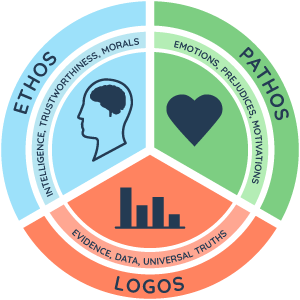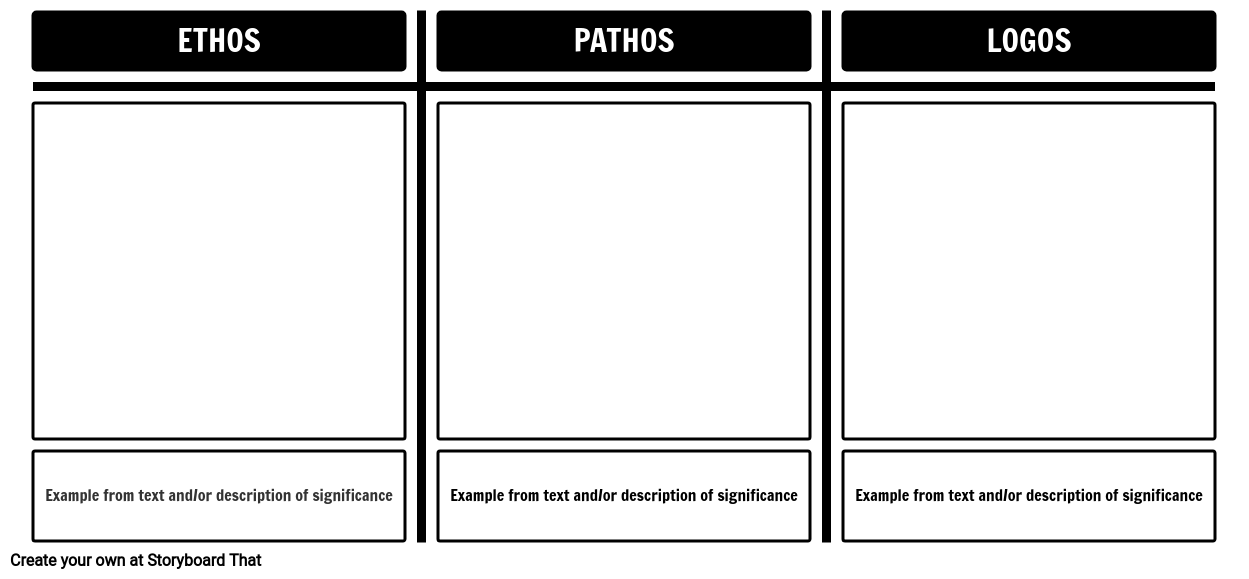Lesson Plan Overview
Douglass’s narrative is more than an interesting account of his difficult life. Written two decades before slavery was outlawed, the narrative was intended as a powerful argument against slavery. In making this argument, Douglass employs a number of effective rhetorical devices, including the appeals of ethos, pathos, and logos. Storyboarding can help students concretely identify examples of these and demonstrate understanding not only of Douglass’s argument, but also of the craftsmanship behind the argument. For this three-square storyboard, have students identify and depict an example of each of the three Aristotelian components of rhetoric. Below each depiction, they should explain their reasoning and/or include other written examples as space allows.
Ethos, Pathos, Logos in the Narrative of the Life of Frederick Douglass
LOGOS
Douglass makes a convincing argument due to his well-written, logical account. He uses sophisticated vocabulary along with specific, verifiable names and geographic locations. He writes fairly and gives credit where it is due in order to avoid accusations of unjust bias.
PATHOS
Douglass describes the cruel beatings slaves received in vivid detail. His eloquent language inspires pity in the reader. His accounts are most powerful when he describes witnessing the abuse of others as a terrified child. He writes, "No words, no tears, no prayers, from his gory victim, seemed to move his iron heart from its bloody purpose...I was quite a child, but I remember it. I shall never forget it whilst I remember anything."
ETHOS
Douglass's narrative begins with a preface by well-known abolitionist William Lloyd Garrison and a letter from abolitionist Wendell Phillips. These respected men act as witnesses, testifying to Douglass's good character. Douglass also builds his credibility by refusing to believe in superstitions and depicting himself as a hard-working, intelligent, church-going Christian.
Template and Class Instructions
(These instructions are completely customizable. After clicking "Copy Activity", update the instructions on the Edit Tab of the assignment.)
Student Instructions
Create a storyboard that shows examples of ethos, pathos, and logos from the text.
- Click "Start Assignment".
- Identify one example of each rhetorical strategy: ethos, pathos, and logos.
- Type the example into the description box under the cell.
- Illustrate the example using any combination of scenes, characters, and items.
Lesson Plan Reference
Student Rubric
(You can also create your own on Quick Rubric.)
| Proficient 33 Points | Emerging 25 Points | Beginning 17 Points | |
|---|---|---|---|
| Ethos, Pathos, and Logos | The elements of ethos, pathos, and logos are correctly identified and depicted, and an appropriate quote or summary is provided. There are at least 2 examples provided for each rhetorical element. | Most of the elements of ethos, pathos, and logos are correctly identified and depicted, and an appropriate quote or summary is provided. There are at least 2 examples provided for each rhetorical element. | The elements of ethos, pathos, and logos are incorrectly identified and depicted. Quotes and summaries may be missing or too limited. Only one example may have been provided for each rhetorical element. |
| Artistic Depictions | The art chosen to depict the scenes are accurate to the work of literature. Time and care is taken to ensure that the scenes are neat, eye-catching, and creative. | The art chosen to depict the scenes should be accurate, but there may be some liberties taken that distract from the assignment. Scene constructions are neat, and meet basic expectations. | The art chosen to depict the scenes is inappropriate. Scene constructions are messy and may create some confusion, or may be too limited. |
| English Conventions | Ideas are organized. There are few or no grammatical, mechanical, or spelling errors. | Ideas are mostly organized. There are some grammatical, mechanical, or spelling errors. | Ideas may be disorganized or misplaced. Lack of control over grammar, mechanics, and spelling reflect a lack of proofreading. |
Lesson Plan Overview
Douglass’s narrative is more than an interesting account of his difficult life. Written two decades before slavery was outlawed, the narrative was intended as a powerful argument against slavery. In making this argument, Douglass employs a number of effective rhetorical devices, including the appeals of ethos, pathos, and logos. Storyboarding can help students concretely identify examples of these and demonstrate understanding not only of Douglass’s argument, but also of the craftsmanship behind the argument. For this three-square storyboard, have students identify and depict an example of each of the three Aristotelian components of rhetoric. Below each depiction, they should explain their reasoning and/or include other written examples as space allows.
Ethos, Pathos, Logos in the Narrative of the Life of Frederick Douglass
LOGOS
Douglass makes a convincing argument due to his well-written, logical account. He uses sophisticated vocabulary along with specific, verifiable names and geographic locations. He writes fairly and gives credit where it is due in order to avoid accusations of unjust bias.
PATHOS
Douglass describes the cruel beatings slaves received in vivid detail. His eloquent language inspires pity in the reader. His accounts are most powerful when he describes witnessing the abuse of others as a terrified child. He writes, "No words, no tears, no prayers, from his gory victim, seemed to move his iron heart from its bloody purpose...I was quite a child, but I remember it. I shall never forget it whilst I remember anything."
ETHOS
Douglass's narrative begins with a preface by well-known abolitionist William Lloyd Garrison and a letter from abolitionist Wendell Phillips. These respected men act as witnesses, testifying to Douglass's good character. Douglass also builds his credibility by refusing to believe in superstitions and depicting himself as a hard-working, intelligent, church-going Christian.
Template and Class Instructions
(These instructions are completely customizable. After clicking "Copy Activity", update the instructions on the Edit Tab of the assignment.)
Student Instructions
Create a storyboard that shows examples of ethos, pathos, and logos from the text.
- Click "Start Assignment".
- Identify one example of each rhetorical strategy: ethos, pathos, and logos.
- Type the example into the description box under the cell.
- Illustrate the example using any combination of scenes, characters, and items.
Lesson Plan Reference
Student Rubric
(You can also create your own on Quick Rubric.)
| Proficient 33 Points | Emerging 25 Points | Beginning 17 Points | |
|---|---|---|---|
| Ethos, Pathos, and Logos | The elements of ethos, pathos, and logos are correctly identified and depicted, and an appropriate quote or summary is provided. There are at least 2 examples provided for each rhetorical element. | Most of the elements of ethos, pathos, and logos are correctly identified and depicted, and an appropriate quote or summary is provided. There are at least 2 examples provided for each rhetorical element. | The elements of ethos, pathos, and logos are incorrectly identified and depicted. Quotes and summaries may be missing or too limited. Only one example may have been provided for each rhetorical element. |
| Artistic Depictions | The art chosen to depict the scenes are accurate to the work of literature. Time and care is taken to ensure that the scenes are neat, eye-catching, and creative. | The art chosen to depict the scenes should be accurate, but there may be some liberties taken that distract from the assignment. Scene constructions are neat, and meet basic expectations. | The art chosen to depict the scenes is inappropriate. Scene constructions are messy and may create some confusion, or may be too limited. |
| English Conventions | Ideas are organized. There are few or no grammatical, mechanical, or spelling errors. | Ideas are mostly organized. There are some grammatical, mechanical, or spelling errors. | Ideas may be disorganized or misplaced. Lack of control over grammar, mechanics, and spelling reflect a lack of proofreading. |
How Tos about Narrative of the Life of Frederick Douglass: Ethos, Pathos, & Logos
Engage students in a classroom debate on Douglass’s use of ethos, pathos, and logos
Debates encourage students to actively discuss and analyze Douglass’s rhetorical strategies. This helps them develop deeper understanding and critical thinking skills as they defend or challenge the impact of ethos, pathos, and logos in his narrative.
Assign student roles as 'ethos', 'pathos', or 'logos' experts
Divide students into three groups and assign each group one rhetorical appeal to become the classroom 'expert' on. This fosters ownership of learning and ensures that students dig deeply into their assigned strategy.
Guide groups to find new textual evidence for their assigned appeal
Challenge each group to search the text for additional examples not already discussed. This builds research and close reading skills while expanding their understanding of Douglass’s argument.
Facilitate a structured debate using group findings
Host a debate where each group presents evidence and explains why their appeal is most persuasive. This gives students real-world practice in argumentation, evidence use, and public speaking.
Reflect on debate outcomes and connect to real-world issues
Lead a class reflection to discuss which rhetorical appeals were most effective and why. Help students connect these techniques to current events or persuasive writing in their own lives.
Frequently Asked Questions about Narrative of the Life of Frederick Douglass: Ethos, Pathos, & Logos
What are examples of ethos, pathos, and logos in the Narrative of the Life of Frederick Douglass?
Ethos is shown through endorsements by respected abolitionists and Douglass's moral character; pathos appears in vivid, emotional descriptions of slavery's cruelty; logos is demonstrated by Douglass’s logical, fact-based arguments and specific details.
How can I teach ethos, pathos, and logos using Frederick Douglass’s narrative?
Have students identify and illustrate one example of ethos, pathos, and logos from the text, then explain their choices in writing. Storyboarding helps students visualize and analyze rhetorical strategies effectively.
Why does Frederick Douglass use ethos, pathos, and logos in his narrative?
Douglass uses ethos to establish credibility, pathos to evoke emotional responses, and logos to present logical arguments—strengthening his anti-slavery message and persuading readers of his viewpoint.
What is an easy lesson plan for teaching rhetorical appeals with Douglass's narrative?
Assign students to create a three-part storyboard: one square each for ethos, pathos, and logos examples from the narrative. Ask them to illustrate and describe each example to demonstrate understanding.
What is the difference between ethos, pathos, and logos in persuasive writing?
Ethos appeals to credibility or character, pathos appeals to emotions, and logos appeals to logic and reason. Effective persuasive writing often blends all three strategies.
More Storyboard That Activities
Narrative of the Life of Frederick Douglass
This Activity is Part of Many Teacher Guides
Testimonials

“By using the product, they were so excited and they learned so much...”–K-5 Librarian and Instructinal Technology Teacher

“I'm doing a Napoleon timeline and I'm having [students] determine whether or not Napoleon was a good guy or a bad guy or somewhere in between.”–History and Special Ed Teacher

“Students get to be creative with Storyboard That and there's so many visuals for them to pick from... It makes it really accessible for all students in the class.”–Third Grade Teacher
© 2026 - Clever Prototypes, LLC - All rights reserved.
StoryboardThat is a trademark of Clever Prototypes, LLC, and Registered in U.S. Patent and Trademark Office










